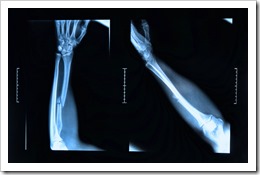The Effects of chaste tree berry (Vitex agnus castus) extract and magnesium on fracture healing in women with long bone fractures.
The purpose of this study was to investigate the effects of chaste tree with and without magnesium on the healing of long bone fractures in young women.
In this double-blind randomized placebo-controlled clinical trial, 64 women ages 20 to 45 y.o. with a traumatic (injury) long bone fracture (upper arm=humerus,  forearm= radius or ulna, upper leg=femur or lower leg=tibia), were enrolled. All of these patients were treated with surgery for their fracture. The patients were randomized to one of four groups: either the chaste tree (1 tablet containing 4 mg of a dried fruit extract), plus placebo, or the chaste tree extract plus magnesium oxide 250 mg/day or magnesium plus placebo or placebo plus placebo daily, for 8 weeks. A questionnaire was given at the beginning of the study that included age, fracture cause, any history of a previous fracture as well as anatomical location of that fracture. They were also categorized into 3 groups according to the amount of physical activity they usually did= light (household tasks, riding in a car, light activity while sitting), moderate (walking 3-5 km/h, light sport, occasional gardening or husbandry), or severe (rigorous sports, agriculture or husbandry).
forearm= radius or ulna, upper leg=femur or lower leg=tibia), were enrolled. All of these patients were treated with surgery for their fracture. The patients were randomized to one of four groups: either the chaste tree (1 tablet containing 4 mg of a dried fruit extract), plus placebo, or the chaste tree extract plus magnesium oxide 250 mg/day or magnesium plus placebo or placebo plus placebo daily, for 8 weeks. A questionnaire was given at the beginning of the study that included age, fracture cause, any history of a previous fracture as well as anatomical location of that fracture. They were also categorized into 3 groups according to the amount of physical activity they usually did= light (household tasks, riding in a car, light activity while sitting), moderate (walking 3-5 km/h, light sport, occasional gardening or husbandry), or severe (rigorous sports, agriculture or husbandry).
Nutritional intake was evaluated by a food frequency questionnaire. Blood tests were taken including alkaline phosphatase, osteocalcin, and vascular endothelial factor (VEGF), plus standard X-ray, all at the beginning and after 8 weeks.
Sixty four patients entered the study and 51 completed it. The 14 patients were excluded due to not taking the supplements adequately or lack of returning for follow-up. The starting fracture rates were distributed in 52.9% in the tibia, 25.5% in the femur, 13.7% in the humerus and 7.8% in the radius and ulna. A total of 21.6% had a previous history of fractures.
Comparison of the average differences of alkaline phosphatase levels at the beginning and end of the treatment intervention was not statistically significant between the four groups. The only group in which there was any increase in alkaline phosphatase was in the chaste tree only group. There was a difference in the average value of osteocalcin between the groups. The increased osteocalcin level in the chaste tree and magnesium group was significant compared to the chaste tree alone or placebo alone. There were no significant differences in the average values of VEGF variation in the study groups although again, the chaste tree only group did have some increase. Most importantly, x-ray evidence of the percentage of callus formation at the site of the fracture (a sign of healing), was most significant in the chaste tree and magnesium group (80%), then the chaste tree 71.4%), magnesium alone (50.0%) and placebo (53.8%).
These results suggest that administration of chaste tree plus magnesium may promote fracture healing in premenopausal women with long bone fractures of the arm or leg.
Comments: This study is a new and innovative idea for the treatment of long bone fractures in young women, especially in the realm of using chaste tree for this purpose. It deserves pointing out that the group of women studied was not postmenopausal women let alone not postmenopausal women with low bone density or outright osteoporosis. It would be important not to extrapolate the results to those women, although I would find no harm in adding chaste tree and magnesium to enhance healing of fractures in those women.
In summary, the combination use of chaste tree and magnesium may synergistically improve fracture healing by increased osteocalcin and VEGF levels and callous formation, even for just 8 weeks.
Reference
Eftekhari M, Rostami Z, Emami M, Tabatabaee H. Effects of vitex agnus castus extract and magnesium supplementation, alone and in combination, on osteogenic and angiogenic factors and fracture healing in women with long bone fracture. J Res Med Sci. 2014;19(1):1-7

